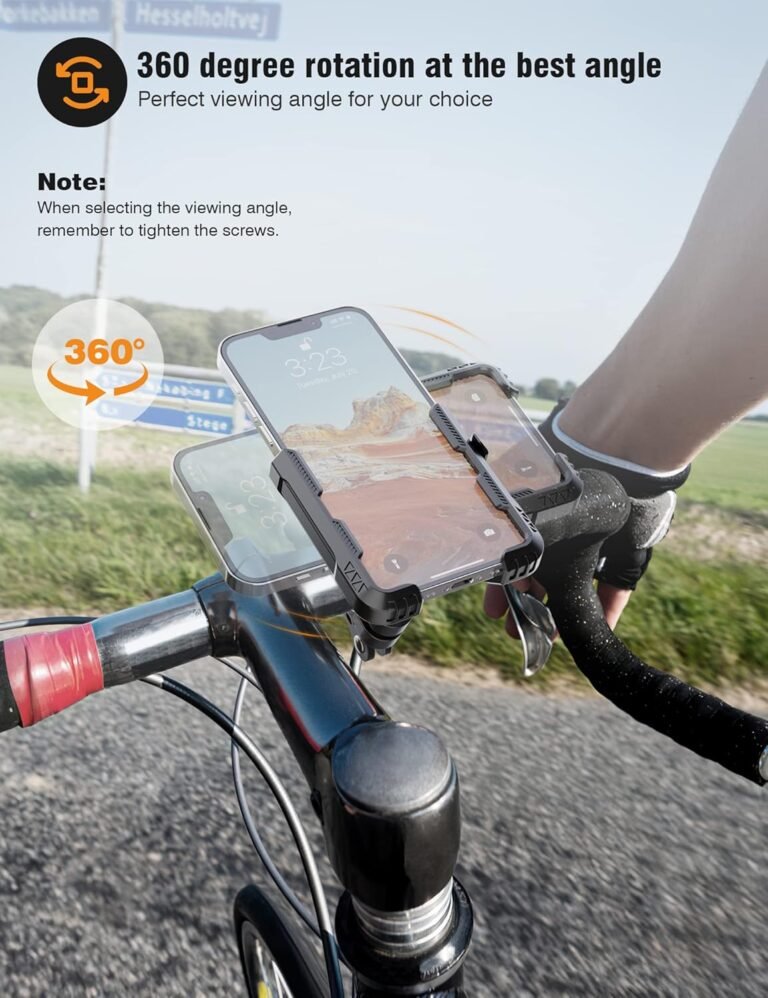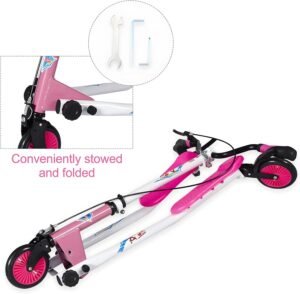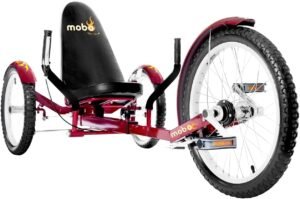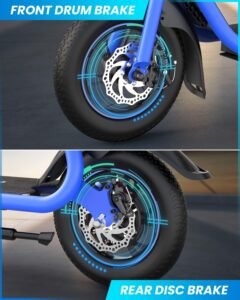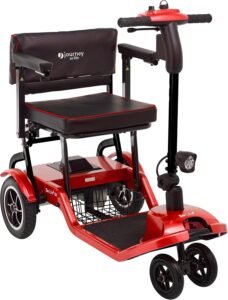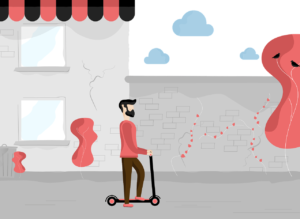
Riding a scooter can be a fun and efficient way to get around town, but it’s important to stay safe while doing so. In this article, we will explore some simple strategies that you can implement to prevent common scooter accidents. From wearing protective gear to being mindful of your surroundings, these tips will help ensure that your scooter rides are both enjoyable and accident-free. So let’s get started and learn how to stay safe on the roads!

This image is property of images.unsplash.com.
Check out our product reviews!
Importance of Helmet Usage
Wear a helmet at all times while riding a scooter
When it comes to scooter safety, wearing a helmet is absolutely essential. The human brain is a delicate organ, and protecting it should be a top priority. By wearing a helmet, you greatly reduce the risk of sustaining a head injury in the event of an accident. A helmet acts as a barrier between your head and any potential impact, absorbing the force and minimizing the chances of serious injury. So, whether you’re riding for a short distance or a long journey, always remember to wear your helmet. It could be a life-saving decision.
Choose a helmet that fits properly
Wearing a helmet is not enough – it needs to be the right fit. Ill-fitting helmets may not provide the necessary protection and can even be uncomfortable, potentially distracting you while riding. To choose the right helmet size, measure the circumference of your head just above your eyebrows. Make sure to select a helmet that corresponds to your head size. It should fit snugly without being overly tight or loose. Trying on different helmets before making a final decision can help you find the perfect fit.
Ensure the helmet is properly fastened
Wearing a helmet is important, but it won’t be much use if it’s not securely fastened. Before setting off on your scooter, double-check that the chin strap of your helmet is properly secured. It should fit snugly under your chin, with the strap comfortably tightened. A properly fastened helmet will stay in place, providing optimal protection in the event of a collision or fall. So, never underestimate the importance of fastening your helmet securely – it could make all the difference.
Replace the helmet if it has been involved in an accident or shows signs of damage
Helmets are designed to withstand the impact of a single accident, after which their effectiveness may be compromised. If you’ve been involved in a scooter accident, even if you don’t see any visible damage to your helmet, it is strongly recommended to replace it. The structural integrity of the helmet may have been compromised during the accident, leaving you vulnerable to a head injury in the future. Additionally, over time, helmets can incur wear and tear, reducing their protective capabilities. Regularly inspect your helmet for any signs of damage, such as cracks or dents, and if you find any, promptly replace it with a new one. Your safety is worth the investment.
Traffic Safety Education
Attend scooter safety education programs
When it comes to riding a scooter safely, knowledge is power. Attending scooter safety education programs can equip you with valuable information about traffic rules, regulations, and best practices. These programs are designed to educate scooter riders on various aspects of safe riding, including understanding road signs, recognizing potential hazards, and adopting defensive riding techniques. By participating in these programs, you can become a more informed and responsible scooter rider, minimizing the risk of accidents and ensuring your safety on the road.
Learn and understand local traffic laws and regulations
Each region and country has its own set of traffic laws and regulations. Take the time to familiarize yourself with the specific rules that apply to scooter riders in your area. This knowledge will help you navigate the roads safely and legally. Understanding the speed limits, right-of-way rules, and other traffic regulations relevant to scooters is crucial for avoiding accidents and conflicts with other road users. Consider reading the local traffic laws or seeking guidance from local authorities to ensure you are aware of the rules and can adhere to them while riding.
Observe traffic signs and signals
Traffic signs and signals are put in place for a reason – to ensure the smooth flow of traffic while keeping everyone safe. As a responsible scooter rider, it is important to observe and obey these signs and signals. Be attentive to traffic lights, stop signs, yield signs, and other important road markings. Understanding and following these signals will not only help you avoid accidents but will also contribute to maintaining order on the road. Remember, adhering to traffic signs and signals is not optional – it’s your duty as a responsible scooter rider.
Practice defensive riding techniques
Defensive riding is a mindset that prioritizes safety and anticipates potential hazards on the road. When you adopt a defensive riding approach, you are constantly aware of your surroundings, actively looking out for any possible dangers, and taking preventive measures to avoid accidents. This includes maintaining a safe following distance from other vehicles, being cautious at intersections, and anticipating the actions of other road users. Defensive riding also involves being prepared to react quickly and appropriately to unexpected situations. By practicing defensive riding techniques, you greatly reduce the risk of being involved in an accident and increase your overall safety on the road.

This image is property of images.unsplash.com.
Check out our product reviews!
Safe Riding Practices
Maintain a safe speed and avoid excessive acceleration
Maintaining a safe speed is crucial for scooter riders. Speeding and excessive acceleration can increase the likelihood of losing control of your scooter or being unable to react to unexpected obstacles in your path. Always ride at a speed that allows you to maintain full control of your scooter and react promptly to any potential hazards. Remember, it’s better to arrive at your destination a little later than to risk a serious accident due to excessive speed.
Don’t ride under the influence of alcohol or drugs
Riding a scooter under the influence of alcohol or drugs is not only illegal but also extremely dangerous. Alcohol and drugs impair your judgment, coordination, and reaction time, significantly increasing the risk of accidents. Even small amounts of alcohol can negatively affect your ability to operate a scooter safely. If you plan on consuming alcohol or taking medication that may impair your cognitive abilities, always make alternative transportation arrangements. Your safety and the safety of others on the road should always be your top priority.
Avoid distractions while riding, such as using a phone
Distractions while riding can be fatal. Using your phone, texting, or even adjusting your music playlist takes your attention away from the road, leaving you vulnerable to accidents. To ensure a safe ride, it is important to stay focused and fully attentive. Keep your phone securely stowed away during your journey and resist the urge to check messages or notifications. Remember, a momentary distraction can have lifelong consequences. Keep your eyes on the road and your hands on the handlebars, and save the phone usage for when you have safely reached your destination.
Keep both hands on the handlebars
Maintaining full control of your scooter requires having both hands on the handlebars. Riding with one hand or no hands dramatically reduces your ability to steer, brake, and react to sudden changes in the road or traffic conditions. Both hands on the handlebars provide stability and ensure that you can maneuver your scooter safely. So, resist the temptation to take your hands off the handlebars while riding, even if it’s just for a moment. Your safety depends on it.
Use turn signals when changing direction
Signaling your intentions to other road users is crucial for maintaining a safe riding environment. When you need to change direction or make a turn, always use your scooter’s built-in turn signals. Signaling your intentions helps other drivers, pedestrians, and cyclists anticipate your movements and adjust their own accordingly. This simple action can significantly reduce the risk of collisions and ensure a smoother flow of traffic. So, make it a habit to use your turn signals every time you need to change direction – it’s a small action that can have a big impact on your safety.
Go with the flow of traffic and avoid weaving through cars
Integration with the flow of traffic is an important aspect of safe scooter riding. Avoid weaving through cars or riding between lanes, as it increases the chances of accidents and can be unpredictable for other road users. Instead, ride in a straight line and follow the flow of traffic, like any other vehicle. When you integrate smoothly with the traffic, it allows other drivers to anticipate your movements, reducing the risk of collisions. By being a predictable part of the traffic pattern, you enhance your safety and the safety of those around you.
Proper Scooter Maintenance
Regularly inspect the scooter for any mechanical issues
Regular inspections of your scooter can help identify any potential mechanical issues before they become major problems. Make it a habit to visually inspect your scooter before each ride. Look for loose or damaged parts, leaks, or anything that doesn’t seem right. Pay attention to the tires, brakes, lights, mirrors, and any other essential components. If you notice something amiss, it’s important to address it promptly by taking your scooter to a qualified mechanic. Regular inspections and maintenance can prevent small issues from escalating into major accidents.
Check tire pressure and ensure adequate tread depth
Proper tire maintenance is vital for a safe scooter ride. Check your tire pressure regularly, as both low and high pressure can affect your scooter’s handling and stability. Refer to the manufacturer’s recommendations for the ideal tire pressure. Additionally, inspect the tread depth of your tires. Tires with worn-out or inadequate tread may result in poor traction, especially on wet or slippery surfaces. If you notice that your tire tread is worn out, it’s time to replace your tires to ensure optimal safety on the road.
Test the brakes before every ride
Functioning brakes are essential for your safety as a scooter rider. Before embarking on a ride, always test your brakes to ensure they are in good working order. Apply gentle pressure to both the front and rear brakes, checking for any abnormalities, unusual sounds, or reduced stopping power. If you notice any issues or are unsure about the condition of your brakes, it is recommended to have them inspected and serviced by a professional. Don’t take chances with faulty brakes – they are your primary means of stopping in case of emergencies.
Ensure all lights are working properly
Visibility is key when riding a scooter, especially during darker hours or adverse weather conditions. Regularly check that all your lights are functioning properly. This includes headlights, taillights, brake lights, and turn signals. A malfunctioning light not only compromises your visibility to others but also increases the risk of accidents. If you notice any non-functioning lights, replace them immediately. Making sure your lights are in good working order is a simple yet effective way to enhance your safety on the road.
Keep the scooter clean to maintain visibility
A clean scooter is not just for aesthetic purposes – it also plays a crucial role in maintaining visibility while riding. Dust, debris, and grime can accumulate on your scooter, obstructing your view and making it harder for others to see you. Regularly clean your scooter, paying attention to the mirrors, lights, and windshield. This will ensure optimal visibility and reduce the chances of accidents caused by reduced visibility. Keeping your scooter clean is a small effort that can have a significant impact on your safety.
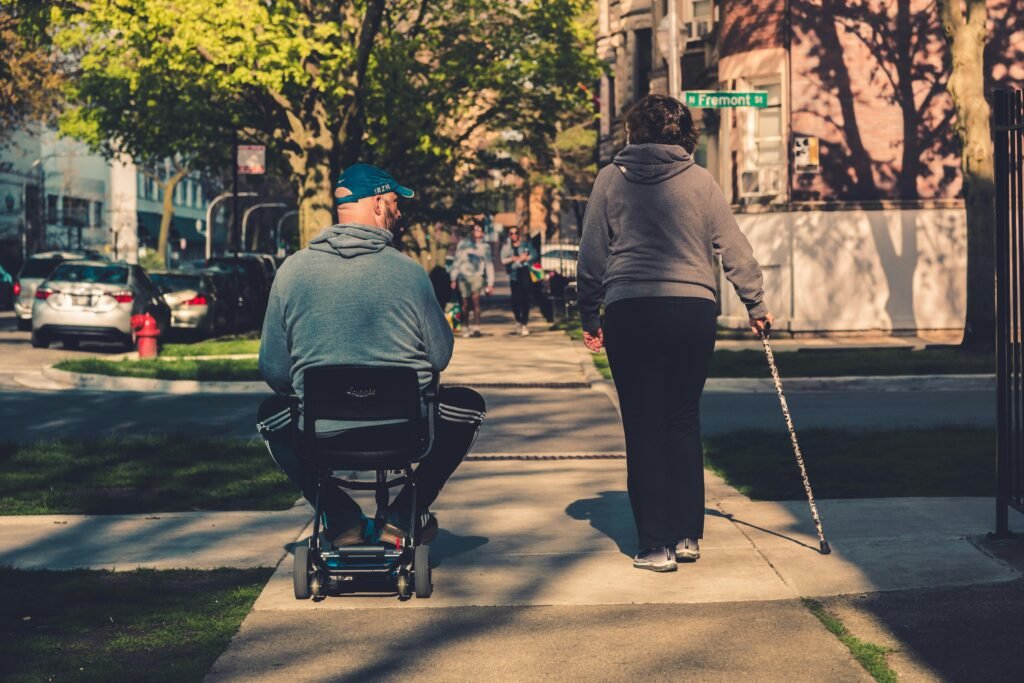
This image is property of images.unsplash.com.
Learning to Balance and Control
Practice balancing and controlling the scooter in a safe environment
For new riders or those who may be getting back on a scooter after a long gap, practicing balancing and controlling the scooter is essential. Find a safe and open area, such as an empty parking lot or a quiet street, to practice your riding skills. Gradually increase your speed and practice maintaining balance while making gentle turns. By practicing in a controlled environment, you can build your confidence, enhance your skills, and improve your overall control over the scooter. Remember, the more comfortable you are with your balance and control, the safer you’ll be on the road.
Learn how to turn smoothly and maintain stability
Smooth and controlled turns are crucial for safe scooter riding. When making turns, avoid sudden jerks of the handlebars and maintain stability throughout the maneuver. Gradually lean into the turn, using your body weight and maintaining a firm grip on the handlebars. Practicing turning in a safe environment will help you develop the necessary muscle memory and coordination required for smooth turns. Remember, mastering the art of turning smoothly enhances your control over the scooter and reduces the risk of accidents.
Master braking techniques to stop safely
Effective braking techniques are vital for your safety as a scooter rider. Learning how to brake safely and efficiently reduces the stopping distance and allows you to respond quickly to unforeseen circumstances. Practice gradual and controlled braking, using both the front and rear brakes, to familiarize yourself with their response. Avoid slamming on the brakes, as it can cause the scooter to skid or lose balance. By mastering proper braking techniques, you can stop safely and confidently in a variety of situations.
Be aware of weight distribution and how it affects balance
Understanding weight distribution and its impact on scooter balance is crucial for safe riding. As a rider, your position on the scooter affects its overall stability. When starting from a stop or navigating corners, shift your weight slightly forward to maintain balance and control. Awareness of your body’s position and how it affects the scooter’s balance will allow you to make necessary adjustments while riding. By maintaining proper weight distribution, you can ride more confidently and handle the scooter with ease, minimizing the risk of accidents caused by poor balance.
Visibility and Protective Gear
Wear bright and reflective clothing to increase visibility
Being visible to other road users is vital for your safety while riding a scooter. Wearing bright and reflective clothing dramatically increases your visibility, especially during low light conditions or inclement weather. Opt for colors that stand out, such as neon or fluorescent hues. Reflective elements on your clothing can further enhance your visibility, reflecting light from other sources, such as car headlights. By making yourself more visible, you significantly reduce the risk of accidents caused by other drivers not seeing you on the road.
Use reflective tape on the scooter for added visibility
Enhancing the visibility of your scooter itself is also important for safety. One effective way to do this is by applying reflective tape to various parts of your scooter, such as the front and rear fenders. Reflective tape is made to reflect light, making your scooter more noticeable to other road users. During low light conditions or at night, the reflective tape will catch the light from car headlights, alerting others to your presence. Adding reflective tape to your scooter is a simple and cost-effective way to increase your visibility and minimize the risk of accidents.
Install lights on the scooter, especially when riding at night
Visibility is crucial for safe scooter riding, especially when riding at night. Installing additional lights on your scooter, such as LED lights or auxiliary headlights, can significantly enhance your visibility to others on the road. These extra lights can illuminate the path ahead of you and make you more visible to other drivers and pedestrians. When selecting additional lights for your scooter, ensure they comply with local laws and regulations, both in terms of brightness and positioning. Maximize your visibility by using lights that are specifically designed for scooters and ensure they are properly installed and aligned.
Consider wearing protective gear, such as knee and elbow pads
Protective gear is an additional layer of defense for scooter riders. While helmets are mandatory, considering additional protective gear, such as knee and elbow pads, can further reduce the risk of injuries in case of a fall or collision. These pads provide cushioning and support to vulnerable areas of your body, absorbing the impact and reducing the severity of injuries. When choosing protective gear, opt for high-quality products that offer a proper fit and coverage. Wearing the right protective gear adds an extra level of protection and ensures you can ride with confidence and peace of mind.
Avoid Riding in Hazardous Conditions
Don’t ride in inclement weather like rain, snow, or heavy winds
Inclement weather conditions are often unpredictable and can pose significant risks for scooter riders. Rain, snow, or heavy winds can reduce visibility, affect traction, and make it harder to control your scooter. Whenever possible, avoid riding in these hazardous weather conditions. If you find yourself caught in bad weather while riding, seek shelter until the conditions improve or consider alternate means of transportation. Your safety should always take precedence over reaching your destination quickly.
Avoid riding on uneven or slippery surfaces
Uneven or slippery surfaces can be treacherous for scooter riders. These surfaces increase the chances of losing control of your scooter, potentially leading to a fall or collision. Be particularly cautious when encountering gravel, oil spills, wet leaves, or icy patches. These surfaces can significantly reduce traction and make it more challenging to maneuver your scooter safely. When faced with such surfaces, slow down, keep a steady grip on the handlebars, and make gradual movements to maintain control. If possible, take alternative routes that avoid these hazardous conditions altogether.
Stay away from crowded or congested areas
Crowded or congested areas can pose unique challenges for scooter riders. Heavy traffic, numerous pedestrians, and a range of other road users can make it difficult to navigate safely. Avoid riding in densely populated areas during peak hours whenever possible. Doing so reduces the chances of accidents caused by sudden movements, distractions, or lack of maneuvering space. If you need to travel through crowded areas, exercise extra caution, maintain a safe distance from other vehicles and pedestrians, and be prepared to adapt to changing traffic conditions.
Be cautious when riding at dusk or dawn
Dusk and dawn are times when visibility may be compromised due to low light conditions. During these transitional periods between day and night, the contrast between the dim outdoors and bright artificial lights can affect your ability to see and be seen. If you must ride during these times, take extra precautions to ensure your visibility. Follow the tips mentioned earlier, such as wearing reflective clothing and using additional lights on your scooter. Additionally, be mindful of your surroundings, stay vigilant, and adjust your riding speed to account for the reduced visibility.
Awareness of Surroundings
Constantly scan the environment for potential hazards
Maintaining awareness of your surroundings is crucial for safe scooter riding. Always be vigilant and actively scan the environment for potential hazards. Look out for pedestrians crossing the road, vehicles changing lanes, or any other unexpected situations that may arise. By continuously assessing your surroundings, you can anticipate potential dangers and take preemptive measures to avoid accidents. Your ability to stay alert and aware is key to keeping yourself safe on the road.
Keep a safe distance from other vehicles
Maintaining a safe following distance from other vehicles is essential for scooter riders. By keeping a safe distance, you provide yourself with ample time and space to react to sudden changes in traffic conditions. It also reduces the risk of rear-end collisions. Adhere to the general rule of leaving a gap of at least two seconds between yourself and the vehicle in front of you. This gap should be increased in adverse weather or when riding at higher speeds. By keeping a safe distance, you give yourself the necessary buffer zone to maneuver and avoid accidents.
Be mindful of pedestrians and share the road responsibly
Scooter riders share the road with various other users, including pedestrians. It is important to be respectful and mindful of pedestrians while riding. Yield the right-of-way to pedestrians at crosswalks and intersections, and always look out for them when making turns or changing lanes. Slow down when approaching areas with heavy pedestrian traffic, such as shopping districts or school zones. Being considerate and sharing the road responsibly creates a safer environment for everyone and reduces the risk of accidents.
Watch out for opening car doors
An unexpected hazard for scooter riders is the opening of car doors. As you ride alongside parked cars, be cautious and watch out for any signs of movement from the vehicles. It is not uncommon for drivers or passengers to open their doors without checking for approaching scooters or bicycles, resulting in potentially serious accidents. Maintain a safe distance from parked cars, allowing yourself enough time to react if a door suddenly opens. By being attentive and prepared, you can avoid potentially dangerous collisions with car doors.
Extra Precautions for New Riders
Take a scooter riding course
For new riders, taking a scooter riding course is highly recommended. These courses teach essential riding skills and provide valuable guidance on scooter safety. Qualified instructors can help new riders navigate through potential challenges, build confidence, and master the basics of safe riding. Additionally, scooter riding courses often include practical exercises and simulations that allow participants to practice real-life scenarios in a controlled environment. By investing in proper training and education, new riders can acquire the skills and knowledge necessary for safe and enjoyable scooter riding.
Start with low-traffic areas before venturing into busy streets
For new riders, starting in low-traffic areas is an excellent way to gain confidence and develop necessary riding skills. Quieter neighborhoods, empty parking lots, or dedicated practice areas can provide an ideal environment for beginners to familiarize themselves with their scooter and practice basic maneuvers. Once you feel comfortable and in control, gradually transition to busier streets and higher traffic areas. This progressive approach allows you to build your skills and adapt to various traffic situations without overwhelming yourself. Remember, mastering the basics in a controlled environment paves the way for safer riding in more challenging settings.
Practice emergency maneuvers, such as sudden braking
Being prepared for emergencies and unexpected situations is crucial for every scooter rider. Practice emergency maneuvers, such as sudden braking or swerving, in a safe and controlled environment. Familiarize yourself with your scooter’s capabilities and how it responds to abrupt changes. By doing so, you will develop the necessary muscle memory and reflexes to react quickly and effectively during critical moments. Regularly practicing emergency maneuvers ensures that you are adequately prepared to navigate through unexpected challenges and increases your overall safety on the road.
Regular Inspection of Scooter Infrastructure
Report any damaged or malfunctioning scooters to the appropriate authorities
As a responsible scooter rider, if you come across any damaged or malfunctioning scooters in public rental programs, it is important to report them to the appropriate authorities. This proactive approach helps identify potential safety hazards before they cause accidents or injuries to other riders. Look out for scooters with broken parts, punctured tires, or any other signs of damage. By reporting these issues, you contribute to the overall safety of the scooter-sharing program and ensure that all riders have access to properly functioning scooters.
Check for loose bolts, worn-out handlebar grips, or other potential hazards
Regularly inspect your own scooter for any signs of wear and tear or potential hazards. Pay special attention to things like loose bolts, worn-out handlebar grips, or other components that may impact your control or stability. Tighten loose bolts, replace worn-out grips, and address any other issues promptly. Conduct these inspections on a regular basis, preferably before each ride, to ensure that your scooter is in optimal condition and ready for a safe journey. By being proactive with scooter maintenance, you minimize the risk of accidents caused by mechanical failures or equipment malfunctions.
In conclusion, adopting safe and responsible practices while riding a scooter is essential for minimizing the risk of accidents and ensuring your safety on the road. By wearing a properly fitted helmet, attending safety education programs, practicing defensive riding techniques, maintaining your scooter, and being aware of your surroundings, you can significantly enhance your safety as a scooter rider. Remember, as a scooter rider, you have the power to protect yourself and others by following these guidelines and making safety a top priority in every ride. So gear up, ride responsibly, and enjoy the freedom and joy that scooter riding brings – safely!






